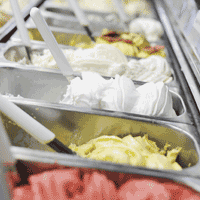Despite rising costs, frozen dairy treats remain fixtures.
There’s something universal about creamy frozen desserts. While the Italians perfected gelato, and the French are serious about sorbet, apparently ice cream was invented in 7thcentury China. So it’s perhaps not surprising that one now bumps into Häagen-Dazs, Baskin-Robbins and Ben & Jerry’s scoop shops in the industrial northern Chinese city of Xian — or on the flip side, that Canadians love a bowl of lychee or green tea ice cream, too.
Regardless of flavour profile, the category continues to grow — especially for companies that embrace the diversity of customer tastes. “Sometimes we look up in the store and we are the only Caucasian faces,” says Robyn MacKay of MacKay’s Ice Cream in Cochrane, Alta., “It’s so amazing to see ladies in saris, African people in traditional garb, it’s like the United Nations. It’s so cool.”
The Mackay family began making ice cream in this small town just outside of Calgary more than 60 years ago, and has always thrived by responding to changing times. They still make patriarch Jimmy MacKay’s recipe — a premium-style ice cream with low overrun — that’s rich, decadent and popular with their many customers, whether they line up at the busy scoop shop (for a double -oz. cone at $6.50), buy MacKay’s by the tub in supermarkets (16 oz. for about $6.75) or taste it at an upscale city restaurant. “We’ve never changed our high-quality, high butterfat base recipe, but we keep up with flavours and multicultural changes,” says MacKay who says serving the growing Asian market is an important part of the business.
“We sell a lot of durian, young coconut, purple yam, lychee, green tea and halo halo,” she says. “Now, in our take-home freezer, at least one-quarter of the flavours are specialty Asian flavours.” It’s a trend purveyors of frozen dairy treats need to embrace as the country’s demographics and ethnic mix change. According to an Agriculture and Agri-Food Canada study of consumer trends, “Canadian immigration, primarily from Asian countries has averaged well over200,000 per year in recent years. This influx of people from different cultures is believed to have both a direct and indirect impact on food consumption patterns in Canada.”
That means lower milk consumption overall — especially fluid milk — while paradoxically, cream and cheese consumption is rising. According to the Dairy Producers of Canada, fluid milk consumption has declined steadily and shifted to one-per-cent milk, while cream has experienced a significant rise in consumption. And while ice cream consumption has
actually dropped, especially in the grocery trade, ice milk, gelato and frozen yogurt products have taken up much of the decline. That may translate into less dairy consumption by volume, but it doesn’t mean we’ve stopped eating frozen desserts — only that we’ve shifted our tastes to high-end, hand-made, artisan products.
Fortunately for those picky producers, The Canadian Dairy Commission, which controls domestic production and enforces strict quality standards, says it protects both producers and consumers by paying sustainable prices to farmers and ensuring consumers are guaranteed a safe Canadian milk supply. This is especially significant now that American dairy farmers are using artificial Bovine Growth Hormone (BGH or recombinant Bovine Somatotrop in, rBST which is banned in Canada) to produce higher volumes of cheaper milk.The artificial hormone, first developed by Monsanto in 1994, increase smilk production by 12 to 16 per cent, but causes infected udders (mastitis) and other health problems in dairy cows. Studies have also shown that the milk produced by cows treated with rBST has increased levels of the hormone IGF-1 (associated with breast, prostate and colon cancers), is lower innutrition, and sours earlier due to pus and bacteria in the milk.
Purity is something ice-cream maker and former chef Shelley Westgarth can appreciate for her artisan Belly Ice Cream, which she unashamedly says is the richest and most expensive ice cream in Ontario. “It would be nice if I could buy organic milk directly from organic farms here in Ontario, but I’m glad we can guarantee we’re using local milk and cream, without these growth hormones,” she says. “I haven’t seen a huge rise in prices since I started, but I don’t have a huge mark-up and I can’t raise prices any higher.”
Working out of a commercial kitchen in Muskoka, Westgarth makes all natural ice cream and gelato with locally sourced ingredients, ranging from wildflower honey and maple, to berries, stone fruits, coffee and even beer. It sells for $8 a pint at cottage country farmers markets, and up to $15 a pint at posh Toronto groceries such as McEwan and Pusateri’s. “Flavours change with the fields and my mood,” says Westgarth of her obscene chocolate brownie, Woolwich Chevre marbeled with Bala cranberry sorbetto, Saigon cinnamon with spiced maple walnuts, candied sour Ontario cherry with dark chocolate, and basil gelato.
All are also favourites on the menu at Eclipse at Deerhurst Resort, the restaurant she ran as head chef, before giving birth to twins and turning her talents to upscale ice cream.“I needed to find a day job,” she quips of her one-woman, artisan operation that involves turning out five-litre batches, with a small ice-cream machine, and filling every container by hand. Westgarth has a roster of 18 flavours of ice cream and gelato, all with very low overrun and some with up to 22-per-cent butterfat. “It’s dense and chewy, with intense flavour and a super-smooth texture,” she says. “It’s expensive but it sells like crazy because it’s the same thing you’d have at a fine-dining restaurant, and really adds that wow factor to a dessert.”
It’s that “wow” factor Vancouver pastry chef Eleanor Chow wants for her dessert creations, too. “I’ve always used ice cream or sorbet as an ddition to other desserts,” says Chow who has worked at restaurants such as Lumière and Chambar and now creates custom flavours for restaurants like Bao Bei. “I like to have lots of different textures and flavours on the plate and ice cream adds that creamy, cold dimension.”
This summer, Chow and partner Favita Johnson will open Cadeaux Bakery Café, featuring its own line of Sweet Ellie’s ice cream. Chow as made port and walnut ice cream with onions and herbs for savoury dishes in the past, but wants to bring ice cream back to its roots. “Certain herbs and spices can work— strawberry or melon with basil, or pineapple with black pepper and saffron,” says Chow, who’s planning malty milk chocolate ice cream and lemon buttermilk sorbet. “But I want to get back to the simplicity of it.”
Simplicity and familiarity are significant factors when you consider the biggest consumers of ice cream and what flavours they love. According to the researchers at Chicago-based Technomic, publishers of the Canadian Dessert Consumer Trends Report 2010, customers aged 18 to 35 consume the most in every frozen-treat category, with 47 per cent saying they have vanilla ice cream—the most approachable of all frozen desserts—at least once a month, compared with 45 per cent among those aged 35 and older. The demographic margin widens considerably when you consider the burgeoning gelato market, a category found more readily in foodservice than at retail. Only 15 per cent of total respondents claimed to have eaten this rich frozen dessert at least once a month, with 27 per cent of those 18 to 35 saying they regularly enjoy gelato, while just 10 per cent of those 35 and older could say the same.
Perhaps an indication of the younger demographic in action, while rich, premium ice cream is popular, health-conscious consumers are pushing gelato and frozen yogurt sales up, too. American frozen yogurt franchises such as Menchie’s (two locations in Toronto) and Spoon Me (now open in Calgary, with more on the way) are making inroads across Canada, serving frozen yogurt with a wide variety of self-serve toppings —from healthy fresh fruit to candy sprinkles and hot fudge sauce. The build-your-own, “pay-by- weight” concept at both franchises means that at 49 cents an ounce, the average cup costs $3 to $6, depending on the toppings. And then there’s gelato —the sexy alternative in the frozen dessert category. Made with fresh fruit and less milk, it’s low in fat but, with a low overrun, is denser than ice cream.
James Coleridge is a new artisan making waves with his Bella Gelateria in the Fairmont Pacific Rim in Vancouver. He’s already being called the best gelato maker in the city (and will represent Canada at the theWorld Cup of Gelato in Italy in 2012). A purist who makes everything from scratch, Coleridge’s 24 flavours of gelato and sorbetto are made from fresh ingredients daily. Only Avalon organic milk from nearby Chilliwack goes into his creamy creations, Bartlett pears and organic cherries come from the Okanagan, and the chocolate is French, from Michel Cluizel. It’s ice cream with a local, Slow Food pedigree and a premium price — $5.95 for a two-scoop serving.
Inside the elegant gelateria, with its striped cream coloured walls and black-and-white checkerboard floor, it feels like you’ve taken a trip to Roma or Torino. The imported Italian Cattabriga EFFE mixers help create a product that’s smooth, creamy and intensely flavoured. Customers follow Coleridge on Twitter to discover what flavour he’s making that day —perhaps a special Sorrento lemon sorbetto or an Indian-inspired kulfi with pistachios, almonds and hints of saffron and cardamom.
On a larger scale, is Mario’s Gelati, founded by namesake Mario LoScerbo in the 1950s after immigrating to Canada from Italy. Today, the Vancouver company, which he still owns, is North America’s largest gelato maker, turning out 30,000 litres of gelato a day and more than 500 products, including its own brands and private labels for other gelato shops.
“It’s a swimming pool of gelato every day,” says Kyra LoScerbo, the company’s operations manager. Mario’s creates a wide range of products for foodservice and wholesale markets, from tubs of Gelato and live-culture frozen yogurt, to portioned frozen desserts such as its popular stuffed lemons and tartufo balls.
Mario’s has its own Amato Gelato Cafe scoop shops in Vancouver and Calgary ($6 for a twoscoop serving), and sells Mario’s Gelato in tubs ($9.50/L), but LoScerbo says its wholesale company feeds gelaterias and brands across Canada and the U.S., Asia and South America. “We sell to lots of other scoop shops, and do lots of custom desserts for chefs,” she says, noting chains such as Milestone’s and Earl’s feature Mario’s Gelati on their menus.
In fact,Mario’s vanilla bean gelato turns up on several dessert menu items at Earl’s, in a supporting role for the chocolate sticky toffee pudding ($8) and as the star of its vanilla bean gelato sundae in a candy snap basket ($7). What’s more, at Milestones, the premium vanilla gelato is served with housemade caramel sauce or chocolate sauce ($6.49),atop a warm dark-and-white chocolate cookie with chocolate and caramel sauce ($6.99).
As with the competition’s icy incarnations,Mario’s, too, has long made flavours to appeal to Vancouver’s Asian community.
“We carry durian in one-litre containers, it’s that popular, and do a lychee sorbet, black sesame, ginger, coconut and mandarin,” she says. “Saffron is popular at the moment for some reason. And in spring, we do more sorbetto. The antioxidant flavours are still popular, too — such as pomegranate and blueberry.”
Some top restaurantsmake ice creams and sorbets in house, but many rely on specialists to create custom frozen desserts for their menus. “It could be a hotel or a restaurant chain or a highend restaurant. We don’t mind if they don’t say it’s ours,” says LoScerbo, who recently made walnut crème brûlée gelato, tomato-basil sorbetto, and gorgonzola and pear crème fraiche gelato for restaurant clients.
Mackay’s also creates custom flavours for restaurants in Calgary — Baklava ice cream for Broken Plate Greek restaurant, vanilla bean black pepper for Escoba Bistro, Limoncello sorbet for the Fairmont Palliser Hotel and Guinness beer ice cream for Buzzards Restaurant & Bar.
Even Denny’s is getting creative with its icecream offerings. This spring the family restaurant chain jumped on the bacon trend with its Baconalia menu, including its maple bacon sundae— vanilla ice cream layered with maple sauce and topped with crumbly bacon.
The Cold Stone Creamery franchise — with 1,400 stores worldwide—makes its super premium ice cream and sorbets fresh daily in every store and gives customers a choice of “mix-ins” from apple pie filling and gumballs to yogurtcovered pretzels. They make big sundaes and icecream shakes (with 1,000 to 2,000 calories per serving, depending on size and flavour), but also serve 110-calorie Sinless Smoothies sweetened with Splenda and Lifestyle Smoothies (250-600 calories) with a boost of energy, antioxidant, protein or anti-stress upplements, including green tea powder, ginseng and ginko biloba.
Meanwhile, popular franchise Dairy Queen remains focused on “family fun,” downsizing some popular items, from DQ shakes and Blizzards to cakes, with mini ice-cream cakes to be introduced soon.
“The mini Blizzard is a smaller Blizzard, which allows our consumers to still treat themselves but in a smaller portion,” says Denise Hutton, vicepresident of Marketing for DQ Canada. “This is especially important as consumers have become more health conscious but still want an occasional treat. Smaller sizes and unique flavours are currently hot trends in the ice-cream market.”
Still, for pastry chefs, like Rhonda Viani of West restaurant in Vancouver, frozen creations are just part of the dessert arsenal. “Nearly all my desserts have something frozen to accompany the dish, or I serve ice cream by itself, in a three- scoop taster ($11.50). Ice cream is one of my favourite things to make—the possibilities, within reason, are endless.
Viani starts with milk and 36-per-cent cream (usually a 50/50 ratio) then gets creative. Most days, she makes at least one new flavour and sometimes she has to put a bowl of ice on top of her aging ice-cream maker to cool the busy motor for the next batch.
Today it’s apple pecan ice cream alongside baked apple sponge pudding with maple candied bacon and pecans ($11), and a tartlet filled with caramelized banana ice cream and rice custard sauce, topped with thin slices of fresh pineapple marinated in passionfruit juice and crunchy puffed granola ($13.50). “Hot, cold, crunchy, intense flavours, unusual textures — that all goes into a great dessert,”Viani says.
Her most unusual creations? “I love to do fennel bulb ice cream, cooked down in orange juice until it’s almost glassy,” says Viani. “We’ve had carrot sorbet, and I’ve done beets often. They’re sweet but earthy.”
And what of the hefty price tag being levied on everything from the finest chef creations to the rising cost per scoop at the local parlour? Viani says restaurateurs are always concerned about rising food costs, but customers still want high-quality ingredients. “If the cost of dairy jumps dramatically, the cost [of ice cream] will have to go up a bit but people are still going to pay,” she says.
No matter what a scoop of their favourite flavour costs, Canadians seem willing to line up for a cone because ice cream is pure comfort food. After all, it’s the treat that came jingling down your suburban street on a summer day: a simple, inexpensive indulgence and always something to celebrate.
Dairy Fat
THERE ARE strict laws covering the labelling of ice cream. To call a product “ice cream” it must have a minimum of 10-per-cent butterfat or milk fat. Premium ice cream contains the highest levels of butterfat, up to 18 per cent, while most commercial ice cream contains between 10-per-cent and 12-per-cent butterfat. Products labelled “ice milk” contain lower levels of butterfat — similar to the soft serve you’d ind at chains like Dairy Queen. Gelato, the Italian answer to ice cream, usually has six- to seven-per-cent dairy fat, but there’s nothing in the Canadian labelling laws to address this particular product. So it must be labelled “frozen dairy dessert,” despite the fact there may be fresh milk or cream in the mix.
Keep Reading
A Look at the Food-preparation Equipment That’s Turning Heads
What’s The Scoop: Local-leaning, Sustainable Cool Treats Are Winning Favour




















